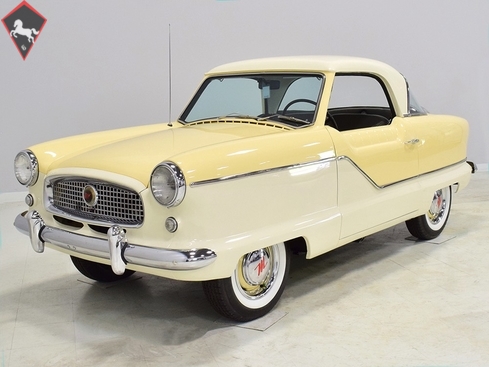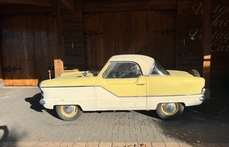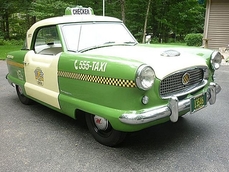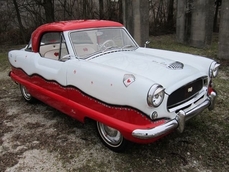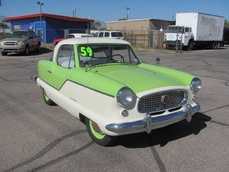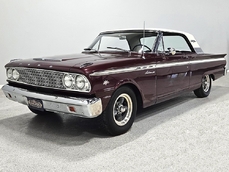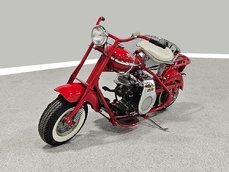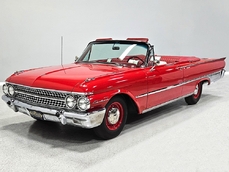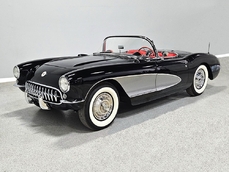Nash Metropolitan 91.4 cubic inch inline-4 1958
General description :
Unquestionably cute, the Nash Metropolitan was also a car ahead of its time. The company that would become AMC saw a need for a car that wouldn’t replace a full-sized automobile, but rather one that could be used around town for running errands—very similar to many of the electric cars that we’re starting to see today. It was economical to buy and to operate, yet still stylish and practical. The small size meant light control effort, so anyone could drive it and it was easy to park. It might rightfully be considered the first truly successful compact car in America and doing it during the 1950s seems like a rather remarkable feat. With a huge enthusiast following, the lovable Met has become the smart hobby car for today’s world, offering wonderful ‘50s styling in a compact package that’s easy on the fuel as well as the eyes.
This particular 1958 Nash Metropolitan coupe has a lot of charm for not a lot of money. It has spent most of the last decade in a museum-like environment and was recently serviced so it’s ready to enjoy. Now some experts might be able to find a few things that aren’t quite factory-correct, but the fact is the fit and finish on this car are light years better than original and befitting of a car worth several times as much. The jaunty two-tone Autumn Yellow over Frost White paint scheme is original, but was only applied after the diminutive body was worked to really sparkle and it really paid off. Check out how tight the door gaps are, how crisp the grooves in the window sill are, and how crisp the line between yellow and white is across the hood. You’ll note there’s a darker yellow pinstripe separating the two, a nice detail that’s probably not quite stock but gives this car a much more expensive look. It's not perfect, but it's far, far nicer than a car at this price point has any right to be. All the chrome was professionally refinished, too, including the egg crate grille and unique bumpers. Out back there’s a continental kit, which was standard equipment on the Met, and it is surrounded by a chrome shell and a matching Arctic White face plate. This is a little car that makes a big statement!
The car is small, no question about it, but you’ll find that it’s easy to get comfortable inside where there’s lots of room for two. The split bench seat has been upholstered in original style checkered fabric with vinyl accents, and legroom is good, even for six-footers. Dramatic black and gray door panels almost look like modern art and the black dashboard is handsome as well as functional. All the relevant instruments are clustered ahead of the driver, with secondary controls just underneath along with the unusual 3-speed shifter that looks odd but feels intuitive in use. The original AM radio is neatly integrated into the dash just above the ignition and offers big, easy-to-use knobs, although it is sadly not functional. New black carpets help it feel comfortable and quiet inside and while there's a back seat, it's probably best for storage or small children. With the spare tire stowed on the outside of the bodywork, the trunk will easily swallow a weekend’s worth of luggage and access is by tilting the rear seat back down. There’s also a jack assembly, just in case.
The Austin A90 donated its 1.5-liter four-cylinder engine making 50 horsepower and enough torque to feel peppy around town. Bearing in mind the car’s modest size and weight, performance is energetic and you’ll find yourself zipping around corners, one of the many benefits of the lightweight design. The engine has been rebuilt and detailed, with bright green paint on the engine itself and properly finished accessories around it. A 1-barrel Zenith carburetor handles induction chores and a reproduction exhaust system gives it an authentic sound that’s sporty without being annoying. Service work included a tune-up, so it starts easily, idles well, and doesn’t have any hiccups in its behavior on the road. It isn’t a long-distance cruiser, but if you use it as intended, you probably won’t be able to have more fun in a car. The three-speed manual transmission shifts nicely and clutch take-up is light, and the engine is torquey enough that you won’t need to do a lot of shifting on the road. Brakes are effective, with drums at all four corners, and steering effort is ideal for tight spots. You’ll also be pleased to note that tires are recent 175/80/13 whitewall radials, which ride well and are still quite affordable, making this a hobby car that’s easy on the wallet now and in the future.
A lovely little car, this Nash is way out at the far end of the quality scale with no hope of recovering the restoration costs. What that means is a big score for the lucky new owner, who gets to enjoy one of the nicest Mets we’ve seen for pennies on the dollar. Call today!
http://www.harwoodmotors.com/vehicles/inventory_details.php?id=996
1958 Nash Metropolitan 91.4 cubic inch inline-4 is listed sold on ClassicDigest in Macedonia by for $13900.
Car Facts
Car type : Car Make : Nash Model : Metropolitan Model Version : 91.4 cubic inch inline-4 Engine size : 1.4 Model Year : 1958 Sub type : Coupé Location : Ohio
Sold
Seller Information
Sold
People who viewed this Nash Metropolitan also viewed similar Nash listed at ClassicDigest
Other cars listed for sale by this dealer
About Nash
Nash Motors, a smaller American manufacturer in comparison to the dominant Detroit "Big Three" automakers (General Motors, Ford, and Chrysler), had its unique identity and history, setting itself apart in several ways:Identity and Distinctions of Nash Motors:
Innovative Features: Nash was known for its pioneering approach to automotive engineering, introducing several innovative features ahead of its time.
Unconventional Design: The company often embraced unconventional designs, including aerodynamic shapes and distinctive styling cues.
Emphasis on Comfort: Nash prioritized passenger comfort, offering spacious interiors and advanced heating and cooling systems.
Advanced Safety Features: They were among the first to incorporate safety features like padded dashboards and seatbelts into their vehicles.
Economic and Fuel-Efficient Cars: Nash cars were recognized for their fuel efficiency and reliability, appealing to a segment of the market seeking economical transportation.
Ten Significant Nash Models with Tech Specs:
Nash Rambler (1950): An early compact car, the Rambler was known for its small size, featuring a 173.3 cubic inch, 82 hp engine, and achieving approximately 25 mpg.
Nash Metropolitan (1953): A subcompact car with a 1.2L engine, it had an economical 42 hp and remarkable fuel efficiency, achieving around 30-40 mpg.
Nash Ambassador (1949-1957): A full-sized car available in various body styles, equipped with a powerful 234 cubic inch, 112 hp engine.
Nash Statesman (1949-1956): Another full-sized model featuring a 184 cubic inch, 85 hp engine and a spacious interior design.
Nash-Healey (1951-1954): A sports car collaboration between Nash and Healey, powered by a 252 cubic inch, 125 hp engine, offering impressive performance for its time.
Nash Airflyte (1949-1951): These models featured a streamlined body design, powered by engines ranging from 172 to 184 cubic inches, producing 82 to 85 hp.
Nash Ambassador Custom (1956): Equipped with a V8 engine of either 250 or 320 cubic inches, offering horsepower in the range of 190-208 hp.
Nash 600 (1941-1949): Introduced before WWII, this model had a 172 cubic inch, 82 hp engine, and a streamlined design for its era.
Nash Lafayette (1934-1940): These models incorporated various engine sizes, ranging from 221 to 234 cubic inches, producing 72 to 95 hp.
Nash Advanced Eight (1933-1934): Featured an inline-eight engine with 298 cubic inches, delivering around 125 hp, an advanced feature for its time.
These Nash models, each with its unique attributes, contributed to the company's reputation for innovation, comfort, and fuel efficiency in the automotive industry.
User
great, same without the bullets
ChatGPT
Certainly, here is a version without bullet points:
Identity and Distinctions of Nash Motors:
Nash Motors, a smaller American manufacturer in comparison to the dominant Detroit "Big Three" automakers (General Motors, Ford, and Chrysler), had its unique identity and history, setting itself apart in several ways:
Innovative Features: Nash was known for its pioneering approach to automotive engineering, introducing several innovative features ahead of its time.
Unconventional Design: The company often embraced unconventional designs, including aerodynamic shapes and distinctive styling cues.
Emphasis on Comfort: Nash prioritized passenger comfort, offering spacious interiors and advanced heating and cooling systems.
Advanced Safety Features: They were among the first to incorporate safety features like padded dashboards and seatbelts into their vehicles.
Economic and Fuel-Efficient Cars: Nash cars were recognized for their fuel efficiency and reliability, appealing to a segment of the market seeking economical transportation.
Ten Significant Nash Models with Tech Specs:
Nash Rambler (1950): An early compact car, the Rambler was known for its small size, featuring a 173.3 cubic inch, 82 hp engine, and achieving approximately 25 mpg.
Nash Metropolitan (1953): A subcompact car with a 1.2L engine, it had an economical 42 hp and remarkable fuel efficiency, achieving around 30-40 mpg.
Nash Ambassador (1949-1957): A full-sized car available in various body styles, equipped with a powerful 234 cubic inch, 112 hp engine.
Nash Statesman (1949-1956): Another full-sized model featuring a 184 cubic inch, 85 hp engine and a spacious interior design.
Nash-Healey (1951-1954): A sports car collaboration between Nash and Healey, powered by a 252 cubic inch, 125 hp engine, offering impressive performance for its time.
Nash Airflyte (1949-1951): These models featured a streamlined body design, powered by engines ranging from 172 to 184 cubic inches, producing 82 to 85 hp.
Nash Ambassador Custom (1956): Equipped with a V8 engine of either 250 or 320 cubic inches, offering horsepower in the range of 190-208 hp.
Nash 600 (1941-1949): Introduced before WWII, this model had a 172 cubic inch, 82 hp engine, and a streamlined design for its era.
Nash Lafayette (1934-1940): These models incorporated various engine sizes, ranging from 221 to 234 cubic inches, producing 72 to 95 hp.
Nash Advanced Eight (1933-1934): Featured an inline-eight engine with 298 cubic inches, delivering around 125 hp, an advanced feature for its time.
These Nash models, each with its unique attributes, contributed to the company's reputation for innovation, comfort, and fuel efficiency in the automotive industry.
